- Orange Solar trajectories split the tropical year into 48 "Tweeks" (7.6 day mean) that are better regarded as quarter-months.
- The year has been split into 16 parts by repeated halving; then each sixteenth part divided into three.
- Solid Blue Lunar lines split cyclical Lunistice Lunistices are the most northerly and southerly moons of the month. The lunar equivalent of solstices. More. position variation into 16 periods of about 14 months each.
mega-what / whole horizon analysis


Solar Axial Alignments
Tap/Click pics for big ones, names for site pages. Prehistoric luni-solar trajectories.
Axial alignments to major solar events such as a Solstice or an Equinox are considerably less frequent than alignments to days that are a quarter or half-month from them, as these examples show.
Although ancient people were interested in the Equinox, Solstices etc, it seems that they were more interested in the full moon nearest to those solar events.
 Bohonagh Stone Circle is axially aligned to the equinox sunset at the south edge of a flat hilltop.
More cleverly, the intersect notch between the base of the hill and further horizons is a solstitial marker. Both sides.
Not the actual solstices however but a half-month from them, labelled Wsol+15 and Ssol-15.
Bohonagh Stone Circle is axially aligned to the equinox sunset at the south edge of a flat hilltop.
More cleverly, the intersect notch between the base of the hill and further horizons is a solstitial marker. Both sides.
Not the actual solstices however but a half-month from them, labelled Wsol+15 and Ssol-15.
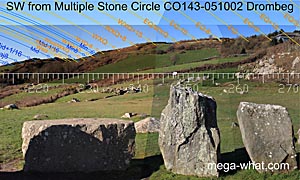 Drombeg Stone Circle has an axis that indicates a horizon notch
which marks the sunset that delimits a month centred on the winter solstice (Wsol+15). Axial reverse indicates lunar major standstill.
Drombeg Stone Circle has an axis that indicates a horizon notch
which marks the sunset that delimits a month centred on the winter solstice (Wsol+15). Axial reverse indicates lunar major standstill.
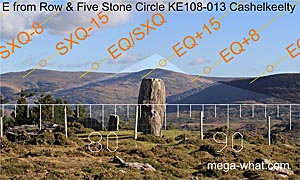 At Cashelkeelty the row axis indicates EQ+15, a half-month from the equinox.
The circle axis has a similar orientation but the portals are now only broken stumps.
At Cashelkeelty the row axis indicates EQ+15, a half-month from the equinox.
The circle axis has a similar orientation but the portals are now only broken stumps.
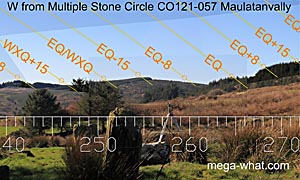 At Maulatanvally Stone Circle
the north portal stone is missing but the axis indicates a hill that is a half-month south of the equinox. The dip south of that is a half-month north of the cross-quarters.
At Maulatanvally Stone Circle
the north portal stone is missing but the axis indicates a hill that is a half-month south of the equinox. The dip south of that is a half-month north of the cross-quarters.
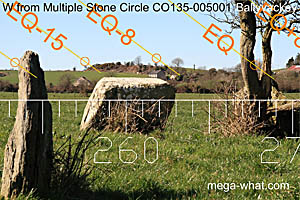 At Ballyvackey
the equinox is in a dip but the quarter and half months to the south of it are at either end of the axial stone. Again, the north portal stone is missing.
At Ballyvackey
the equinox is in a dip but the quarter and half months to the south of it are at either end of the axial stone. Again, the north portal stone is missing.
 At Derreenataggart West the indicated hill has two tops.
A half-month, EQ-15, on one and a quarter-month, EQ+8, on the other. The equinox is at the basal step of the highest top.
At Derreenataggart West the indicated hill has two tops.
A half-month, EQ-15, on one and a quarter-month, EQ+8, on the other. The equinox is at the basal step of the highest top.
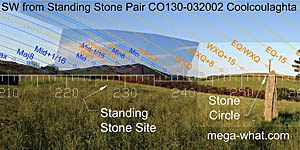 Coolcoulaghta Standing Stone Pair
is an example of a monument axis that makes an accurate sightline for an event lacking a good natural marker. In this case, EQ/WXQ, the equinox/winter cross-quarter midpoint.
Coolcoulaghta Standing Stone Pair
is an example of a monument axis that makes an accurate sightline for an event lacking a good natural marker. In this case, EQ/WXQ, the equinox/winter cross-quarter midpoint.
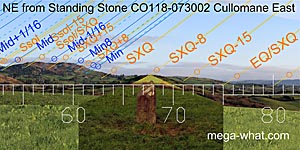 This Standing Stone at Cullomane East is an outlier of a stone circle.
Its axis indicated a hilltop that is a quarter-month south of the summer cross-quarters but the stone has since fallen.
This Standing Stone at Cullomane East is an outlier of a stone circle.
Its axis indicated a hilltop that is a quarter-month south of the summer cross-quarters but the stone has since fallen.
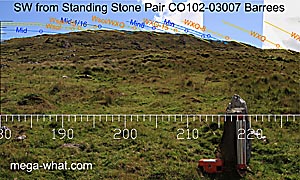 Barrees Standing Stone Pair
indicates WXQ-8, a quarter month south of the winter cross-quarters, on a very high horizon. The axial reverse indicates lunar major standstill.
Barrees Standing Stone Pair
indicates WXQ-8, a quarter month south of the winter cross-quarters, on a very high horizon. The axial reverse indicates lunar major standstill.
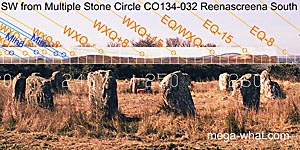 At Reenascreena Stone Circle the axis indicates a dip that is WXQ+8, a quarter-month south of the winter cross-quarters.
The axial reverse indicates SXQ-8, a quarter-month north of the summer cross-quarters, on a hilltop.
At Reenascreena Stone Circle the axis indicates a dip that is WXQ+8, a quarter-month south of the winter cross-quarters.
The axial reverse indicates SXQ-8, a quarter-month north of the summer cross-quarters, on a hilltop.
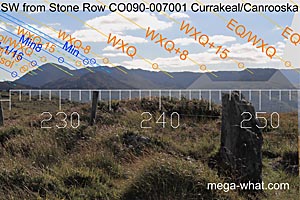 Currakeal / Canrooska Stone Row axis indicates WXQ+15, which is a half-month north of the winter cross-quarters.
Currakeal / Canrooska Stone Row axis indicates WXQ+15, which is a half-month north of the winter cross-quarters.
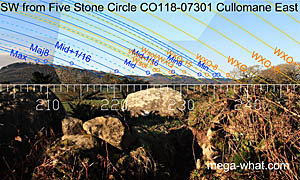 Though Cullomane East Five Stone Circle
has been partially incorporated into a sod & stone field fence its axis clearly indicates the hill marking winter solstice sunset.
Though Cullomane East Five Stone Circle
has been partially incorporated into a sod & stone field fence its axis clearly indicates the hill marking winter solstice sunset.
The Prehistoric Solar Calendar
was developed as an attempt to explain the frequent appearance of certain declination values at significant points on the horizon.
To find these same values indicated by monument axes is confirmation of their importance but not all monuments have both a recoverable axis and unobscured horizons in the axial direction.
| Home | More Axial Alignments | Site Lists | Glossary |